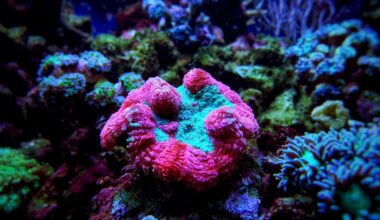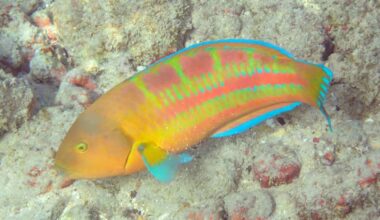
Quick Facts
| Other Names: | Tube Coral, Sunflower Coral, Orange Sun Coral, and Sun Polyps |
| Background: | Dendrophylliidae family and Tubastraea genus |
| Tank: | 10 gallons (minimum) |
| Water Parameters: | 77-80F, 8.1-8.4 pH, 1.023-1.025 SG, Calcium 425 ppm, Magnesium 1200-1350 ppm, Phosphate 0.03 ppm, Ammonia-Nitrate-Nitrite 0 ppm |
| Lighting: | Low, 75 PAR |
| Water Flow: | Moderate flow of 20 to 40 times turnover |
| Size: | Can form colonies 6″ (15 cm) in diameter |
| Growth: | 1.18 to 1.6 inches per year |
| Feeding: | 3-5 times/week brine shrimp, mysid shrimp, and chopped seafood |
| Compatibility: | Ball Sponges, Chili Coral, Sea Fans, Tree Coral |
| Fragging Difficulty: | Low |
If you are looking for a bright coral that does not need lots of light then the Sun Coral will be perfect for your aquarium. This coral is non-photosynthetic which means it can get its nutrients from water currents instead of processing light like photosynthetic corals.
Sun Corals are not aggressive and not too difficult to care for, so we are sure this guide will equip you with the right knowledge to succeed as a coral owner. Let’s get started!
Table of Contents
Species Summary
The Sun Coral is a large polyp stony (LPS) coral that is part of the Tubastraea species. It is also known as the Tube Coral, Sunflower Coral, Orange Sun Coral, and Sun Polyps. This coral is part of the Dendrophylliidae family and Tubastraea genus.
The origin of this beautiful coral includes the Indo-Pacific, specifically the Solomon Islands, the Great Barrier Reef, Tonga, and Fiji. They are usually found in shaded spots such as caves and crevices.
Appearance
With its vibrant orange body and yellow flowing tentacles, it is easy to see why this species is known as the Sun Coral. You can find the coral’s mouth in the center of its body, and its tube-like tentacles are usually closed unless it is feeding time or nighttime.
Popular Sun Coral Species
There are several types of Tubastraea species, and each one has its own physical traits and characteristics. For example, you can find these corals in colors ranging from orange to black. When deciding which coral to add to your aquarium, it is helpful to learn about the four popular Sun Coral species.
Orange Sun Coral (Tubastraea faulkneri)
You can mostly find this coral in the Indo-Pacific Ocean, including Australia, the Philippines, and the Galápagos Islands. This coral does well in spots with adequate nutrients and high water flow, and it is not a natural reef builder.
The common names of this species include Orange Polyp Coral and Golden Cup Coral. It features a yellow and orange color scheme, and the corallites are linked at the base without any space between the polyps.
Tubastraea tagusensis
This species was originally found on the Galápagos Islands, and thanks to their invasive behavior, they can now be found along South America’s Atlantic coastline.
Tubastraea tagusensis does not require a special substrate or ample sunlight to grow, and this species does not build reefs. It can also change other structures to suit its needs, which is why it is easy for this coral to invade multiple coastlines. Unlike other Sun Corals, Tubastraea tagusensis features a white body. One similar physical trait is the tube-like tentacles.
Orange cup coral (Tubastraea coccinea)
Similar to other Sun Corals, the Orange Cup Coral features a yellow and orange body with tube-shaped tentacles.
This coral is also another non-reef-building species found in the Indo-Pacific, the Gulf of Mexico, the Caribbean Sea, and West Africa. While this coral usually takes over spaces and artificial structures not being used by other corals, it does have an invasive behavior toward other benthic invertebrates.
Black sun coral (Tubastraea micranthus)
The Black Sun Coral is dark green with branch-like colonies that grow vertically, and its appearance tends to vary per area. For example, this coral is bigger and stronger near the Philippines than Black Sun Corals found in other regions.
Unlike other species on this list, Tubastraea micranthus is a reef-building coral. It also has great strength and tends to grow faster than other corals. Tubastraea micranthus can be found in areas ranging from the Red Sea to Fiji, and there have also been sightings in Korea. This is an invasive coral that has even made its way to Mississippi.
Sun Coral Care
The level of care required for you Sun Coral is considered to be moderate. They are better suited for intermediate and experienced hobbyists. The biggest challenge is probably creating and keeping a feeding routine since it might retract its polyps and stop eating.
Tank Size
A 10-gallon tank is the minimum recommended size for your Sun Coral so they can have plenty of room to grow. If you are planning to house multiple colonies, you may want to increase the tank size to ensure your species do not disturb one another.
Water Parameters
Regardless of the type of Tubastraea species you choose for your aquarium, maintaining accurate water parameters is essential for your coral’s survival.
Water temperature: 77-80 degrees Fahrenheit
pH levels: 8.1-8.4
Water hardness: 8-12
Specific gravity: 1.023-1.025
Calcium: 425 ppm
Magnesium: 1200-1350 ppm
Phosphate: Less than 0.03 ppm.
Ammonia: 0 ppm
Nitrate: 0 ppm
Nitrite: 0 ppm

Tank Setup
It is not recommended to add a sandy substrate to the tank because it could damage your coral’s tissue and tentacles. A flat surface or rocky cave is ideal for your coral, or you can imitate its natural habitat with a rocky overhang or ledge.
Placement
Sun Corals are not aggressive so where you place them will depend on other species. For example, Birds Nest Corals grow over corals that are placed within two inches of their space so make sure there is always enough distance between them.
Considering Sun Corals are found in caves, placing them at the bottom of the tank with low light will be fine. If you are placing a sandbed in the tank for other species, you can protect your coral by elevating it on a flat surface or allowing it to hang upside-down. This will keep them safe from fish that are constantly sifting and digging like the Diamond Goby.
Lighting
This coral does not require much light because it is non-photosynthetic and it is not from a habitat with a lot of light. Some hobbyists play it safe by keeping their sun corals in a low light environment under 75 PAR. This way, the coral does not become shocked by too much light. Caves, crevices, and overhangs are ideal if you need to add other species that require more lighting.
Filtration / Water Flow
A moderate flow of 20 to 40 times turnover is ideal for your aquarium because it channels food and oxygen towards the coral. This means that if you have a small 10 gallon tank, then you will need a pump and filter with flow rates between 200 and 400 gph.
Author Note: Providing a sufficient flow also removes waste before it can build up on your coral’s tissue and cause an unhealthy environment.
Acclimation
When introducing your Sun Coral to its tank, it may retract its polyps. It is important to stay patient and continue with regular feedings. Eventually, your coral will open its polyps and start eating. Lowering the light or placing your coral in a dark area can also help it get used to its new surroundings.
Growth / Size
The Sun Coral grows faster than some corals, and the colonies can grow 1.18 to 1.6 inches per year. When fully grown, the coral’s height reaches up to 3.15 inches, and the colonies can reach up to 6 inches in diameter.
The corallites can grow up to 0.5 in width and 2 inches in height. As Sun Coral colonies grow, they can create additional communities.
Feeding
These corals rely on capturing their own food rather than obtaining energy from photosynthetic sources, so it is recommended to feed your sun coral at least three to five times a week to ensure they get the nutrients they need. Your coral may also prefer to eat at nighttime when they’re tentacles are extended.
Sun corals enjoy meaty foods such as brine shrimp, mysid shrimp, and chopped seafood. You can also supplement their diet with amino acids and vitamins made for corals.
Author Note: Use a turkey baster or a special tool designed for target feeding to shoot the food toward each polyp’s mouth. Your coral uses its tentacles to capture and eat its food, which is an amazing sight for any hobbyist.
Compatibility
When adding tank mates to your Sun Coral’s aquarium, it is best to choose non-photosynthetic corals. This way, you do not have to worry about contrasting conditions or feedings.
- Ball Sponges
- Chili Coral
- Sea Fans
- Tree Coral
Of course, you want to ensure every colony has plenty of room to grow without trying to invade other communities.
It is also necessary to avoid adding corals that are photosynthetic or very aggressive to the tank. Photosynthetic corals require different lighting and tank mates, while aggressive corals like the ones below may attack your Sun Coral.
- Galaxea coral
- Green Star Polyps
- Long tentacle plate coral
- Finger Leather Coral
Propagation and Fragging
Sun Corals can reproduce by creating and attaching motile larvae called planulae to rocks, or they can create and release small copies of themselves.
If you want to encourage propagation on your own, you can always frag your coral. It is vital to be careful when fragging your coral which is why we created the step-by-step guide below. Those steps are a simplified version of our comprehensive Coral Fragging Guide.
1. Use a sharp tool, such as a tile saw or craft knife, to remove your preferred polyp from the coral. You are cutting through the skeleton and may hit a few tissues, so it is normal for your coral to leak some ooze.
2. Next, secure your freshly cut fragment by wrapping it in a mesh.
3. Place your new fragment in its designated spot in your tank.
4. Continue with regular feedings as your new coral grows over several weeks.
Author Note: When cutting your coral make sure to minimize the damage to the polyps and properly secure the fragments in your tank otherwise they might float away with the flow.
Conclusion
The Sun Coral is a great addition to many aquariums especially those with low lighting and given its non-aggressive behavior, finding the right tank mates should not be a problem. Just remember to be patient when feeding your coral since this can get a bit tricky.
If you will be sharing colorful photos of your sun coral on social media don’t forget to tag us on Facebook and if you are coral fan try our other Coral Care Guides.

